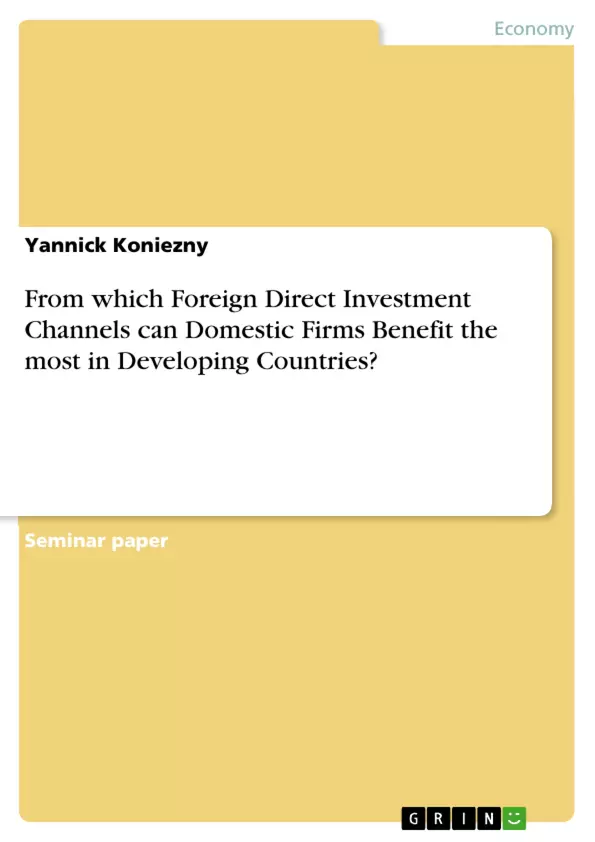In the wake of globalization, the importance of Foreign Direct Investments (henceforth FDI) has strongly increased. From 1990 to 2017 the amount of FDI inflows in the world has increased sevenfold. Most FDI expenditures flow between industrialized countries. But also developing countries show a strong increase in FDI inflows. Especially China became attractive for FDIs in the past years after reducing FDI restrictions. In the year 1978, before substantial reforms, almost no FDIs were made in China. 39 years later, in 2017, approximately 9.5% of the worldwide FDIs were conducted in China. In the same period, the Gross Domestic Product (GDP) per capita of China has increased fifty-six-fold. At the same time, the export ratio of China has increased from approximately 4.5 % to 19.8 %. These developments suggest that FDI may have a positive influence on economic growth and thus on firms' growth in developing countries. Therefore, governments of developing countries try to attract their country and companies for FDI by granting tax holidays or other benefits in the hope that the domestic economy can benefit from positive FDI spillovers.
Companies have various reasons to make an investment in a foreign country e.g. lower wages, new market access, better resources, etc. All those motives are linked to the superior objective of profit maximization. According to John H. Dunning’s "Eclectic paradigm", there are three conditions which must be fulfilled so that companies make an investment in a foreign country. First, the ownership advantage which means that a company must have an exclusive competitive advantage over competitors in the foreign market. Second, the location advantage which means that a company must benefit from the differences between home and host countries for example through lower wages or factor costs and third, the internalization advantage which means that a company must exploit its specific competitive advantages itself and not sell them to existing companies, e.g. in the form of licenses.
Inhaltsverzeichnis (Table of Contents)
- Introduction
- Foreign Direct Investment (FDI)
- Definition
- Types of FDIs
- Horizontal vs. vertical FDIs
- Potential impact of FDIs on domestic firms' growth
- FDI efficiency measures
- Spillovers through FDIs
- Growth determinants
- Conclusion
- References
Zielsetzung und Themenschwerpunkte (Objectives and Key Themes)
This term paper examines the relationship between Foreign Direct Investment (FDI) and the growth of domestic firms in developing countries. The paper seeks to identify which FDI channels offer the greatest benefits to domestic firms and explore the mechanisms through which these benefits occur.
- The role of FDI in economic growth, particularly in developing countries
- Different types of FDI and their potential impact on domestic firms
- The concept of FDI spillovers and their contribution to domestic firm growth
- Key determinants of domestic firm growth in the context of FDI
- The importance of attracting FDI and optimizing its benefits for developing economies
Zusammenfassung der Kapitel (Chapter Summaries)
The paper begins with a comprehensive introduction to the topic of Foreign Direct Investment (FDI) and its increasing significance in a globalized economy. The paper highlights the substantial growth of FDI inflows globally, particularly in developing countries, using data and figures to illustrate these trends. This introduction sets the stage for exploring the potential impact of FDI on the growth of domestic firms.
The second chapter provides a thorough definition of FDI, exploring its various types and differentiating between horizontal and vertical FDI. This chapter lays the groundwork for understanding the different ways in which FDI can affect domestic firms and their growth prospects.
The third chapter delves into the potential impact of FDI on domestic firms' growth. It explores various measures of FDI efficiency and investigates the concept of FDI spillovers, analyzing how these spillovers can contribute to domestic firm growth. The chapter also examines key determinants of domestic firm growth in the context of FDI.
The paper concludes with a summary of the key findings and their implications for policy and future research. This section, however, is excluded from the preview to avoid spoilers.
Schlüsselwörter (Keywords)
The paper focuses on the key themes of Foreign Direct Investment (FDI), domestic firm growth, developing countries, FDI spillovers, FDI efficiency measures, and growth determinants. It examines the different channels through which FDI can influence domestic firms and explores the factors that contribute to successful FDI attraction and utilization. The paper also explores relevant concepts such as horizontal and vertical FDI, the role of multinational enterprises, and the economic impact of globalization.
- Quote paper
- Yannick Koniezny (Author), 2019, From which Foreign Direct Investment Channels can Domestic Firms Benefit the most in Developing Countries?, Munich, GRIN Verlag, https://www.grin.com/document/508838



